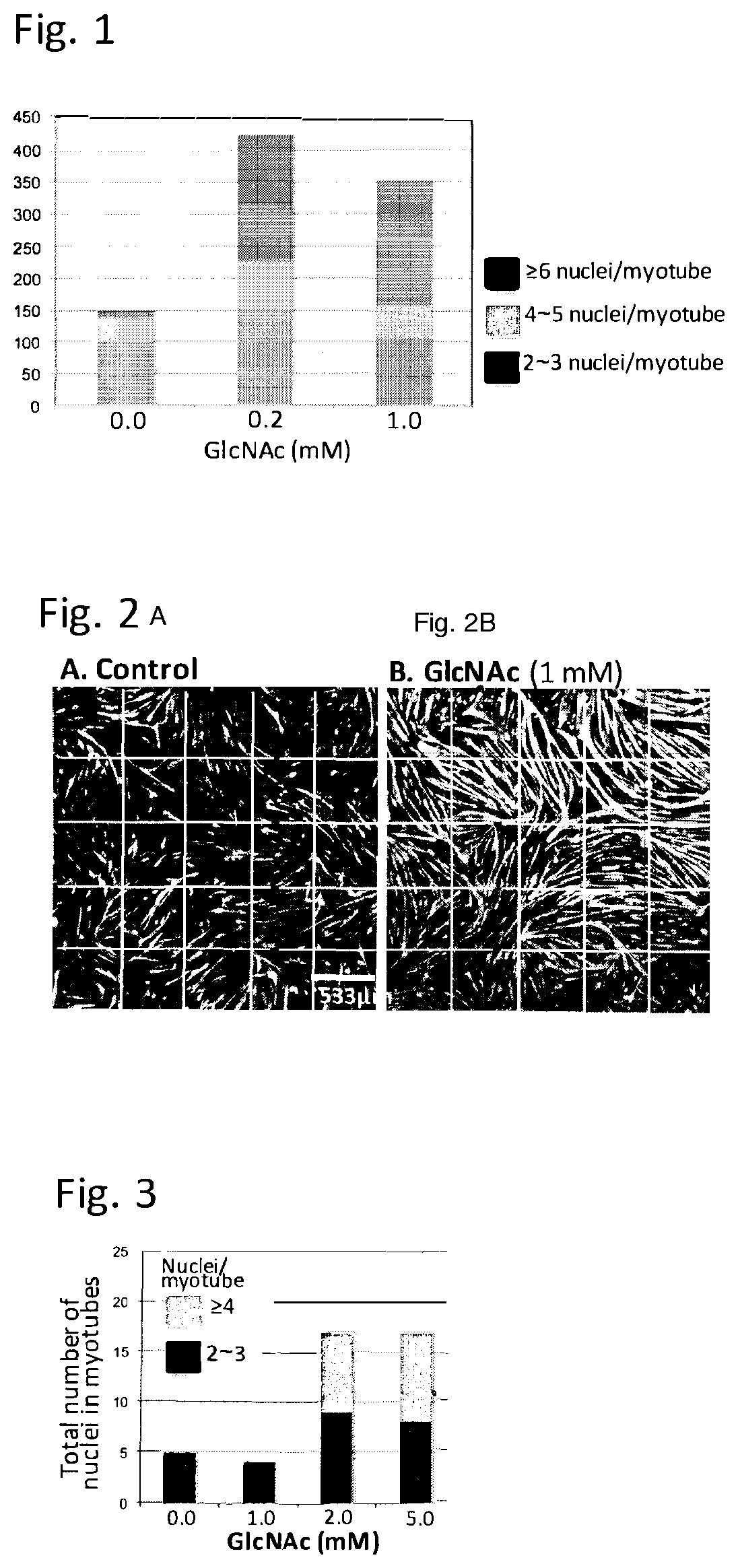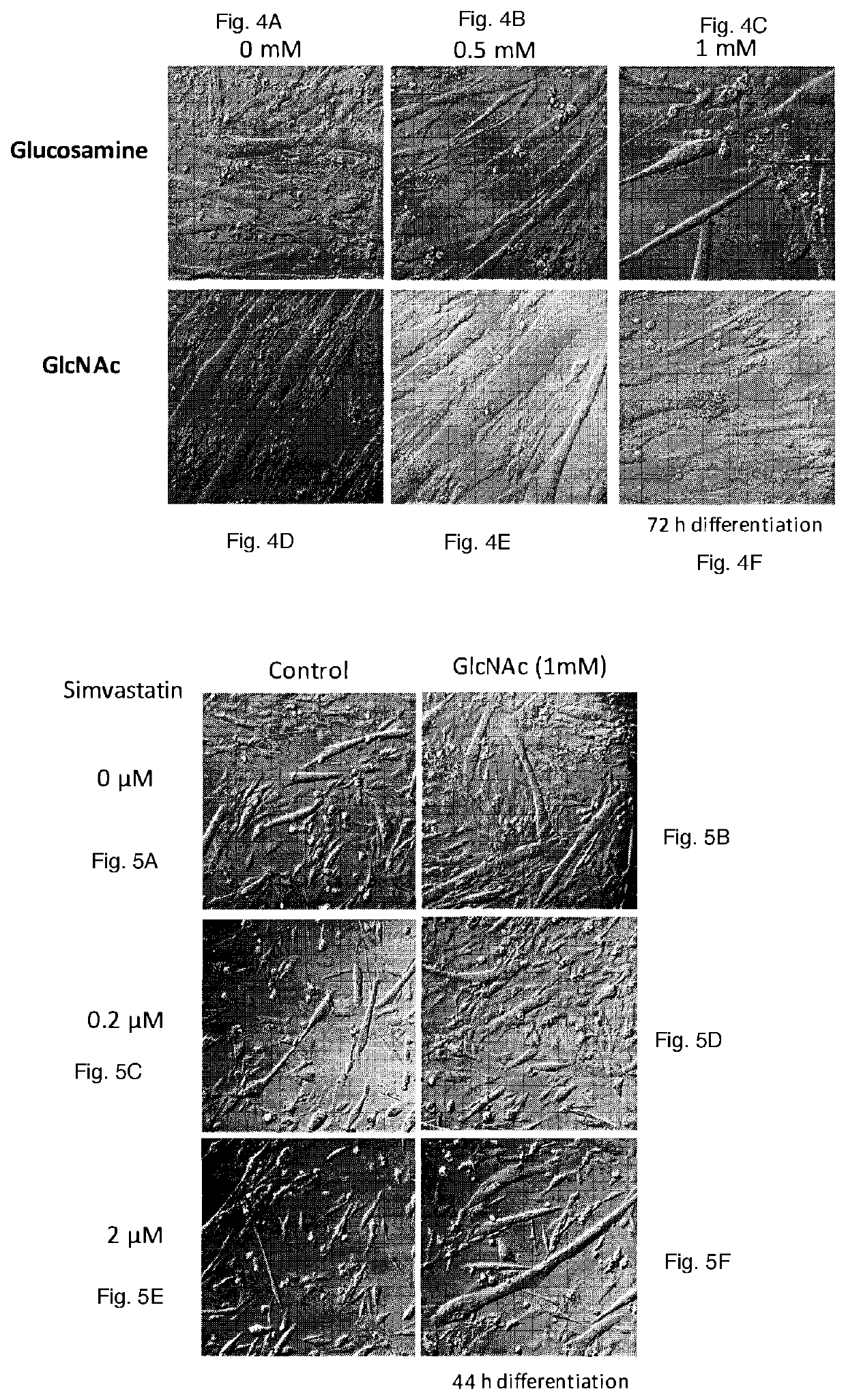Use of N-acetylglucosamine and derivatives thereof to treat muscle disorders
a technology of nacetylglucosamine and derivatives, applied in the field of medicine, can solve the problems of degeneration of fibers affecting the function of muscles, etc., and achieve the effect of delaying the onset of muscular atrophy
- Summary
- Abstract
- Description
- Claims
- Application Information
AI Technical Summary
Benefits of technology
Problems solved by technology
Method used
Image
Examples
example 1
oblasts
[0072]N-Acetylglucosamine promotes myogenesis of murine myoblasts: Myogenesis of murine myoblast cells, C2C12 cells was induced by replacing the medium from growing medium (DMEM supplemented with 10% fetal calf serum) to DMEM supplemented with 1% horse serum, insulin (10 μg / ml), transferrin (5.5 μg / ml) and selenium (5 ng / ml) in the presence or absence of different doses of N-acetylglucosamine (GlcNAc). This condition induces the differentiation of myoblasts, including the induction of the synthesis of myosine heavy chains (MHC). Then myoblasts start fusing with each other to form myotubes, which are multinucleated. Cells were fixed in 3.8% paraformaldehyde containing phosphate buffered saline (PBS) for 15 min. Then cells were permeabilized by PBS-0.25% Triton X100 for 5 min. After washed with PBS, the cells were incubated with anti-MHC antibody (Clone MF-20, 2.5 μg / ml) in the blocking agents (Vectors laboratories) for an hour, followed by anti-mouse antibody labelled with Ale...
example 2
blasts
[0074]GlcNAc Promotes the Myogenesis of Myoblasts Derived from a Patient of Myotonic Dystrophy 1:
[0075]It is known that myogenesis is impaired in myotonic dystrophy 1 (DM1). The therapeutic potential of GlcNAc on this impaired myogenesis was thus tested. Myoblasts derived from a patient of DM1 were grown in DMEM supplemented with 20% fetal calf serum till the density of cells reached to 90% confluency. Then, the differentiation was induced by changing the medium to DMEM supplemented with 1% fetal calf serum, 10 μg / ml insulin, and 100 μg / ml apotransferrin. After 120 hours, cells were fixed and MHC in the cells were visualized by the method described in Example 1. FIG. 3 shows that GlcNAc promote the myogenesis of human myoblasts of DM1, indicating that treatment of GlcNAc can rescue the impaired myogenesis that occurs in DM1 patients.
example 3
ne Vs GlcNAc
[0076]GlcNAc but not its Derivative Glucosamine Promotes the Myogenesis (FIGS. 4A-4F):
[0077]Glucosamine is a commercially available supplement, which has been claimed to reduce arthritic pain, although there is any scientific evidence to support this claim. It was examined whether glucosamine has any significant effect on the myogenesis. Myogenesis of murine myoblast cells, C2C12 cells was induced by replacing the medium from growing medium (DMEM supplemented with 10% fetal calf serum) to DMEM supplemented with 1% horse serum, insulin (10 μg / ml), transferrin (5.5 μg / ml) and selenium (5 ng / ml) in the presence or absence of different doses of N-acetylglucosamine (GlcNAc) or glucosamine. This condition induces the differentiation of myoblasts, including the induction of the synthesis of myosine heavy chains (MHC). Then myoblasts start fusing each other to form myotubes, which are multinucleated. Cells were fixed in 3.8% paraformaldehyde containing phosphate buffered saline ...
PUM
 Login to View More
Login to View More Abstract
Description
Claims
Application Information
 Login to View More
Login to View More - R&D
- Intellectual Property
- Life Sciences
- Materials
- Tech Scout
- Unparalleled Data Quality
- Higher Quality Content
- 60% Fewer Hallucinations
Browse by: Latest US Patents, China's latest patents, Technical Efficacy Thesaurus, Application Domain, Technology Topic, Popular Technical Reports.
© 2025 PatSnap. All rights reserved.Legal|Privacy policy|Modern Slavery Act Transparency Statement|Sitemap|About US| Contact US: help@patsnap.com


